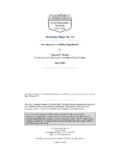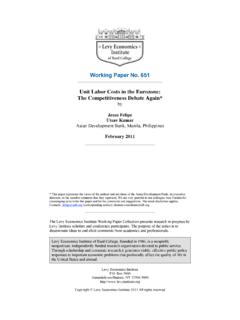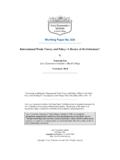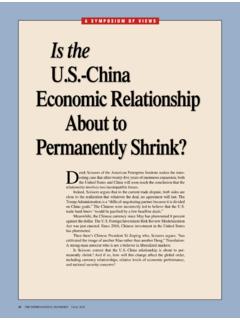Transcription of Working Paper No. 659 - Levy Economics Institute
1 Working Paper No. 659. Minsky Crisis by L. Randall Wray Levy Economics Institute of Bard College March 2011. The Levy Economics Institute Working Paper Collection presents research in progress by Levy Institute scholars and conference participants. The purpose of the series is to disseminate ideas to and elicit comments from academics and professionals. Levy Economics Institute of Bard College, founded in 1986, is a nonprofit, nonpartisan, independently funded research organization devoted to public service. Through scholarship and economic research it generates viable, effective public policy responses to important economic problems that profoundly affect the quality of life in the United States and abroad. Levy Economics Institute Box 5000. Annandale-on-Hudson, NY 12504-5000. Copyright Levy Economics Institute 2011 All rights reserved ABSTRACT.
2 Stability is destabilizing. These three words concisely capture the insight that underlies Hyman Minsky's analysis of the economy's transformation over the entire postwar period. The basic thesis is that the dynamic forces of a capitalist economy are explosive and must be contained by institutional ceilings and floors. However, to the extent that these constraints achieve some semblance of stability, they will change behavior in such a way that the ceiling will be breached in an unsustainable speculative boom. If the inevitable crash is cushioned by the institutional floors, the risky behavior that caused the boom will be rewarded. Another boom will build, and the crash that follows will again test the safety net. Over time, the crises become increasingly frequent and severe, until finally it (a great depression with a debt deflation) becomes possible.
3 Policy must adapt as the economy is transformed. The problem with the stabilizing institutions that were put in place in the early postwar period is that they no longer served the economy well by the 1980s. Further, they had been purposely degraded and even in some cases dismantled, often in the erroneous belief that free markets are self-regulating. Hence, the economy evolved over the postwar period in a manner that made it much more fragile. Minsky continually formulated and advocated policy to deal with these new developments. Unfortunately, his warnings were largely ignored by the profession and by policymakers until it was too late. Keywords: Stability Is Destabilizing; Hyman Minsky; Money Manager Capitalism;. Financial Instability Hypothesis; Global Financial Crisis; Self-Regulating Markets JEL Classifications: B22, B25, B26, B52, E02, E11, E12, E44, G01, O11.
4 1. INTRODUCTION. Stability is destabilizing. Those three words capture in a concise manner the insight that underlies Minsky's analysis of the transformation of the economy over the entire postwar period. The basic thesis is that the dynamic forces of the capitalist economy are explosive so that they must be contained by institutional ceilings and floors. However, to the extent that the constraints successfully achieve some semblance of stability, that will change behavior in such a manner that the ceiling will be breached in an unsustainable speculative euphoria. If the inevitable crash is cushioned by the institutional floors, the risky behavior that caused the boom will be rewarded. Another boom will build, and its crash will again test the safety net. Over time, the crises become increasingly frequent and severe until finally it (a great depression with a debt deflation) becomes possible.
5 While Minsky's financial instability hypothesis is fundamentally pessimistic, it is not meant to be fatalistic (see Minsky 1975, 1982, 1986). Policy must adapt as the economy is transformed. The problem with the stabilizing institutions that had been put in place in the early postwar period is that they no longer served the economy well by the 1980s. Further, they had been purposely degraded and even in some cases dismantled, often on the erroneous belief that free markets are self-regulating. Indeed, that became the clarion call of most of the Economics profession after the early 1970s, based on the rise of new classical Economics with its rational agents and instantaneously clearing markets and the efficient markets hypothesis that proclaimed prices fully reflect all information about fundamentals. Hence, not only had firms learned how to circumvent regulations and other constraints, but policymakers had removed regulations and substituted self-regulation in place of government oversight.
6 From his earliest writings in the late 1950s to his final papers written before his death in 1996, Minsky always analyzed the financial innovations of profit-seeking firms that were designed to subvert New Deal constraints. For example, he was one of the first economists to recognize how the development of the fed funds market had already reduced the Fed's ability to use reserves to constrain bank lending, while at the same time stretching liquidity because banks would have fewer safe and liquid assets should they need to unwind balance sheets (Minsky 1975). And much later, in a remarkably prescient 2. piece in 1987, Minsky had foreseen the development of securitization (to move interest rate risk off bank balance sheets while reducing capital requirements) that would later be behind the global financial crash of 2007 (Minsky 2008).
7 At the same time, Minsky continually formulated and advocated policy to deal with these new developments. Unfortunately, his warnings were largely ignored by the profession and by policymakers until it was too late. MINSKY'S THEORY OF THE BUSINESS CYCLE. In the introduction I focused on long-term transformations because too often Minsky's analysis is interpreted as a theory of the business cycle. There have even been some analyses that attempted to prove Minsky wrong by applying his theory to data from one business cycle. Further, the global crisis that began in 2007 has been called the Minsky moment or a Minsky crisis. As I will discuss, I agree that this crisis does fit with Minsky's theory, but I object to analyses that begin with, say, 2004 attributing the causes of the crisis to changes that occurred over a handful of years that preceded the collapse.
8 Rather, I argue that we should find the causes of the crisis in the transformation that began in 1951. We will not understand the crisis if we begin with a US real estate boom fueled by lending to subprime borrowers. That will be the topic of the next section. Now, Minsky did have a theory of the business He called it an investment theory of the cycle and a financial theory of investment. He borrowed the first part of that from Keynes: investment is unstable and tends to be the driver of the cycle (through its multiplier impact). Minsky's contribution was the financial theory of investment, with his John Maynard Keynes (1975) providing the detailed exposition. In brief, investment is financed with a combination of internal and external (borrowed) funds. Over an expansion, success generates a greater willingness to borrow, which commits a rising portion of expected gross profits (Minsky called it gross capital income) to servicing debt.
9 This exposes the firm to greater risk because if income flows turn out to be less than expected, or if finance costs rise, firms might not be able to meet those debt payment commitments. There is nothing inevitable about that, however, because Minsky 1. See Papadimitriou and Wray (1998) for a summary of Minsky's approach. 3. incorporated the profits equation of Michal Kalecki in his analysis: at the aggregate level total profits equal investment plus the government's deficit plus net exports plus consumption out of profits and less saving out of wages (Minsky 1986). The important point is that all else equal, higher investment generates higher profits at the aggregate level. This can actually make the system even more unstable because if profits continually exceed expectations, making it easy to service debt, then firms will borrow even more.
10 This then leads to Minsky's famous categorization of financial positions: a hedge unit can meet payment commitments out of income flow; a speculative unit can only pay interest but must roll-over principal; and a Ponzi unit cannot even make the interest payments so must capitalize them (borrowing to pay interest). (Minsky borrowed the name of a famous fraudster, Charles Ponzi, who ran a pyramid scheme in more recent times, Bernie Madoff ran another pyramid that failed spectacularly.) Over a run of good times, firms (and households) are encouraged to move from hedge to speculative finance, and the economy as a whole transitions from one in which hedge finance dominates to one with a greater weight of speculative finance. Eventually some important units find they cannot pay interest, driving them to Ponzi finance.
















